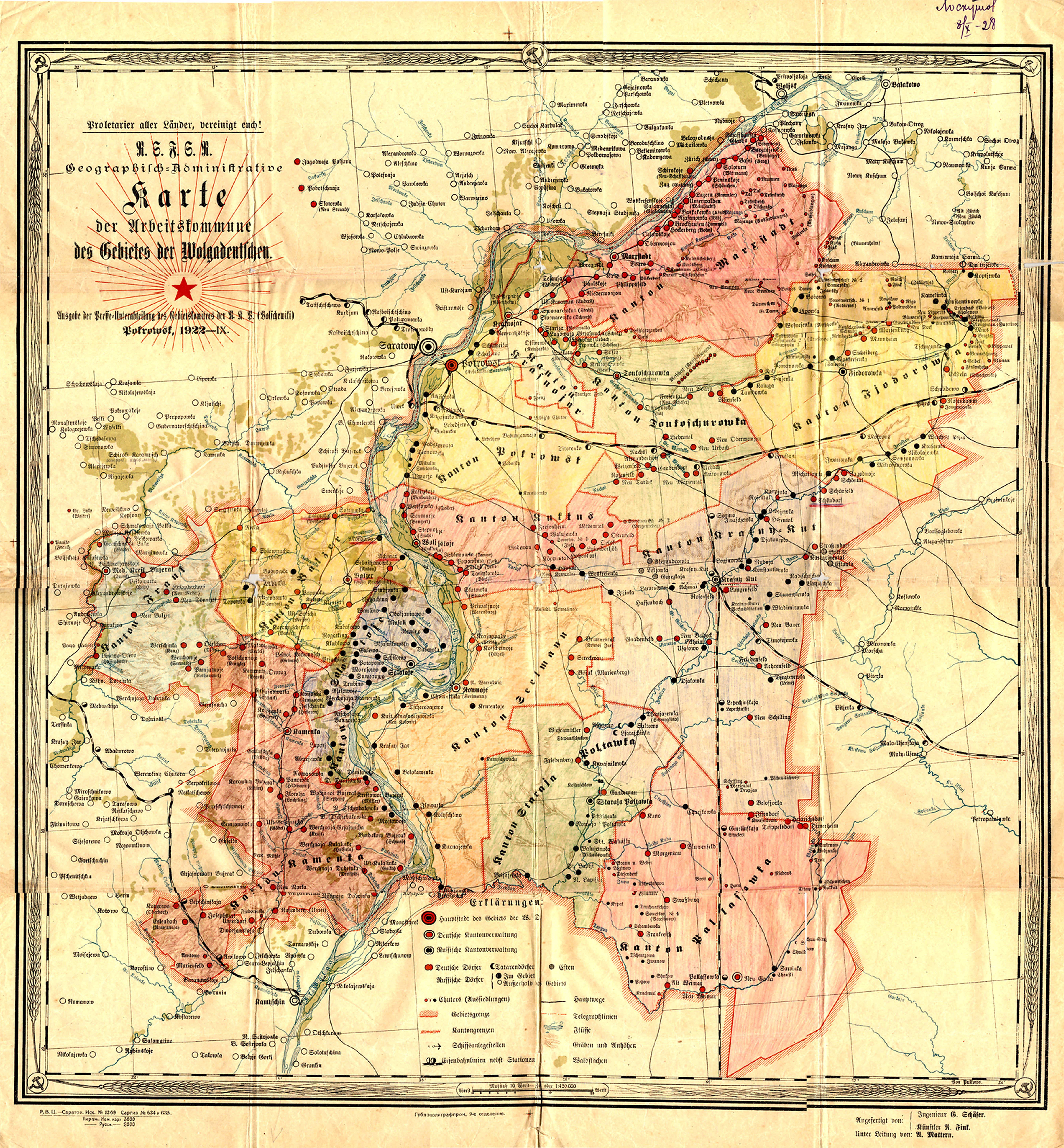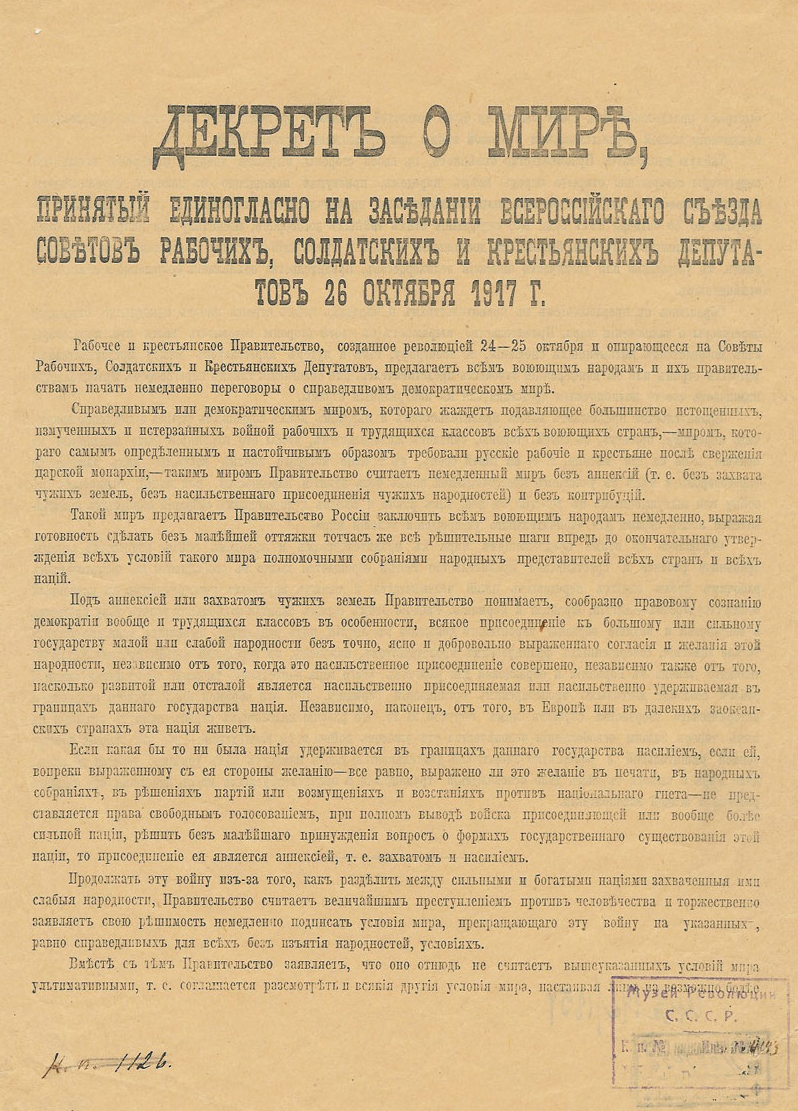|
Volgaland
The Volga German Autonomous Soviet Socialist Republic (; ), abbreviated as the Volga German ASSR, was an autonomous republic of the Russian SFSR. Its capital city was Engels (known as Pokrovsk or Kosakenstadt before 1931) located on the Volga River. As a result of the German invasion of the Soviet Union in 1941, the republic was abolished and Volga Germans were exiled. History The first provision of a special status for Volga Germans in the Russian SFSR was created following the October Revolution, by a 29 October (some claim 19 October) 1918 decree of the Soviet government, establishing the Labour Commune of Volga Germans. This gave Soviet Germans a special status among the non-Russians in the USSR. It was restructured as an Autonomous Soviet Socialist Republic on 20 February 1924 (claims of 19 December 1923), by a declaration of the All-Russian Central Executive Committee and the Council of People's Commissars of the Russian SFSR. It became the first national autonomous unit ... [...More Info...] [...Related Items...] OR: [Wikipedia] [Google] [Baidu] |
Autonomous Soviet Socialist Republics
An Autonomous Soviet Socialist Republic (ASSR, ) was a type of Subdivisions of the Soviet Union, administrative unit in the Soviet Union (USSR), created for certain Demographics of the Soviet Union#Ethnic groups, ethnic groups to be the titular nations of. The ASSRs had a status lower than the constituent republics of the Soviet Union, union republics of the USSR, but higher than the Autonomous oblasts of the Soviet Union, autonomous oblasts and the autonomous okrugs of the Soviet Union, autonomous okrugs. In the Russian Soviet Federative Socialist Republic, Russian SFSR, for example, Chairmen of the Government of the ASSRs were officially members of the Council of Ministers of the Russian SFSR, Government of the RSFSR. Unlike the union republics, the autonomous republics only had the right to disaffiliate themselves from the Union when the union republic containing them did so, as well as to choose to stay with the Union separately from them. The level of political, administrati ... [...More Info...] [...Related Items...] OR: [Wikipedia] [Google] [Baidu] |
Soviet Decree
Decrees () were legislative acts of the highest Soviet institutions, primarily of the Council of People's Commissars (the highest executive body) and of VTsIK (the highest legislative body between sessions of the Congress of Soviets), issued between 1917 and 1924. Such acts issued after 1924 are referred to as Decisions () or s in Soviet sources. Bolshevik Initial Decrees [...More Info...] [...Related Items...] OR: [Wikipedia] [Google] [Baidu] |
Siberia
Siberia ( ; , ) is an extensive geographical region comprising all of North Asia, from the Ural Mountains in the west to the Pacific Ocean in the east. It has formed a part of the sovereign territory of Russia and its predecessor states since the lengthy conquest of Siberia, which began with the fall of the Khanate of Sibir in 1582 and concluded with the annexation of Chukotka in 1778. Siberia is vast and sparsely populated, covering an area of over , but home to roughly a quarter of Russia's population. Novosibirsk, Krasnoyarsk, and Omsk are the largest cities in the area. Because Siberia is a geographic and historic concept and not a political entity, there is no single precise definition of its territorial borders. Traditionally, Siberia spans the entire expanse of land from the Ural Mountains to the Pacific Ocean, with the Ural River usually forming the southernmost portion of its western boundary, and includes most of the drainage basin of the Arctic Ocean. I ... [...More Info...] [...Related Items...] OR: [Wikipedia] [Google] [Baidu] |
Altai Krai
Altai Krai (, ) is a federal subject of Russia (a krai). It borders, clockwise from the west, Kazakhstan ( East Kazakhstan Region, Abai Region and Pavlodar Region), Novosibirsk and Kemerovo, and the Altai Republic. The krai's administrative centre is the city of Barnaul. As of the 2021 Census, the population of the krai was 2,163,693. Name The region is named after the Altai Mountains. History Bone fragments of the Denisova hominin originate from the Denisova Cave in Altai Krai. This area is part of a great crossroads in the ancient world. Nomadic tribes crossed through the territory during periods of migration. These nomadic tribes consisted of different peoples. Archeological sites reveal that ancient humans lived in the area. The Altay people are a Turkic people, some of whom settled here, who were originally nomadic and date back to the 2nd millennium BC. The territory of the krai has been controlled by the Xiongnu Empire (209 BC–93 AD), the Rouran Khaganate (33 ... [...More Info...] [...Related Items...] OR: [Wikipedia] [Google] [Baidu] |
Kazakh Soviet Socialist Republic
The Kazakh Soviet Socialist Republic, also known as Soviet Kazakhstan, the Kazakh SSR, KSSR, or simply Kazakhstan, was one of the transcontinental country, transcontinental Republics of the Soviet Union, constituent republics of the Soviet Union (USSR) from 1936 to 1991. Located in northern Central Asia, it was created on 5 December 1936 from the Kazakh Autonomous Socialist Soviet Republic, Kazakh ASSR, an Autonomous Soviet Socialist Republics of the Soviet Union, autonomous republic of the Russian Soviet Federative Socialist Republic, Russian SFSR. At in area, it was the second-largest republic in the USSR, after the Russian Soviet Federative Socialist Republic, Russian SFSR. Its capital was Almaty, Alma-Ata (today known as Almaty). During its existence as a Soviet Socialist Republic, it was ruled by the Communist Party of Kazakhstan (Soviet Union), Communist Party of the Kazakh SSR (QKP). On 25 October 1990, the Supreme Soviet of the Kazakh SSR declared its sovereignty on ... [...More Info...] [...Related Items...] OR: [Wikipedia] [Google] [Baidu] |
Population Transfer In The Soviet Union
From 1930 to 1952, the government of the Soviet Union, on the orders of Soviet leader Joseph Stalin and under the direction of the NKVD official Lavrentiy Beria, forcibly transferred populations of various groups. These actions may be classified into the following broad categories: deportations of "anti-Soviet" categories of population (often classified as "enemies of the people"), deportations of entire nationalities, labor force transfer, and organized migrations in opposite directions to fill ethnically cleansed territories. Dekulakization marked the first time that an entire class was deported, whereas the deportation of Soviet Koreans in 1937 marked the precedent of a specific ethnic deportation of an entire nationality. In most cases, their destinations were underpopulated remote areas (see Forced settlements in the Soviet Union). This includes deportations to the Soviet Union of non-Soviet citizens from countries outside the USSR. It has been estimated that, in their ... [...More Info...] [...Related Items...] OR: [Wikipedia] [Google] [Baidu] |
Collaboration In The German-occupied Soviet Union
A large number of Soviet citizens of various ethnicities collaborated with Nazi Germany during World War II. It is estimated that the number of Soviet collaborators with the Nazi German military was around 1 million. Aftermath of the German invasion Mass collaboration ensued after the German invasion of the Soviet Union of 1941, Operation Barbarossa. The two main forms of mass collaboration in the Nazi-occupied territories were both military in nature. It is estimated that anywhere between 600,000 and 1,400,000 Soviets (Russians and non-Russians) were “military collaborators” with the Wehrmacht in some way either as ''Hiwis'' (or Hilfswillige) or in some other capacity, including 275,000 to 350,000 "Muslim and Caucasian”. Ahead of the subsequent implementation of the more oppressive administrative methods by the '' SS''. As much as 20% of the German manpower (when including Hiwis) in Soviet Russia was composed of former Soviet citizens, about half of whom were ethnic R ... [...More Info...] [...Related Items...] OR: [Wikipedia] [Google] [Baidu] |
Korenizatsiia
Korenizatsiia (, ; ) was an early policy of the Soviet Union for the integration of non-Russian nationalities into the governments of their specific republics of the Soviet Union, Soviet republics. In the 1920s, the policy promoted representatives of the titular nation, and their national minorities, into the lower administrative levels of the local government, bureaucracy, and nomenklatura of their Soviet republics. The main idea of the korenizatsiia was to grow communist cadres for every nationality. In Russian language, Russian, the term () derives from (, "native population"). The policy practically ended in the mid-1930s with the Population transfer in the Soviet Union, deportations of various nationalities. Politically and culturally, the nativization policy aimed to eliminate Russian domination and culture in Soviet republics where ethnic Russians did not constitute a majority. This policy was implemented even in areas with large Russian-speaking populations; for instanc ... [...More Info...] [...Related Items...] OR: [Wikipedia] [Google] [Baidu] |
Donetsk–Krivoy Rog Soviet Republic
The Donetsk–Krivoy Rog Soviet Republic or Donetsk–Kryvyi Rih Soviet Republic (; ) was a self-declared Soviet republic of the Russian SFSR proclaimed on 12 February 1918. It was founded three days after the government of the Ukrainian People's Republic (UPR) signed its Treaty of Brest-Litovsk with the Central Powers, which recognised the borders of the UPR. Lenin did not support the creation of the entity and neither did Sverdlov. Some other Bolsheviks like Elena Stasova, however, sent a telegraph of best wishes. On 3 March 1918 a separate Treaty of Brest-Litovsk was signed between Soviet Russia and the Central Powers (Germany, Austria-Hungary, the Ottoman Empire, and Bulgaria), by which Russia withdrew from World War I. The Article III of the treaty stated that "the territories lying to the west of the line agreed upon by the contracting parties which formerly belonged to Russia, will no longer be subject to Russian sovereignty" and "the future status of these territorie ... [...More Info...] [...Related Items...] OR: [Wikipedia] [Google] [Baidu] |
Soviet Union
The Union of Soviet Socialist Republics. (USSR), commonly known as the Soviet Union, was a List of former transcontinental countries#Since 1700, transcontinental country that spanned much of Eurasia from 1922 until Dissolution of the Soviet Union, it dissolved in 1991. During its existence, it was the list of countries and dependencies by area, largest country by area, extending across Time in Russia, eleven time zones and sharing Geography of the Soviet Union#Borders and neighbors, borders with twelve countries, and the List of countries and dependencies by population, third-most populous country. An overall successor to the Russian Empire, it was nominally organized as a federal union of Republics of the Soviet Union, national republics, the largest and most populous of which was the Russian SFSR. In practice, Government of the Soviet Union, its government and Economy of the Soviet Union, economy were Soviet-type economic planning, highly centralized. As a one-party state go ... [...More Info...] [...Related Items...] OR: [Wikipedia] [Google] [Baidu] |
Council Of People's Commissars Of The Russian Soviet Federative Socialist Republic
The Council of People's Commissars of the Russian Soviet Federative Socialist Republic was the government of Soviet Russia between 1917 and 1946. It was established by the Second All-Russian Congress of Soviets of Workers', Soldiers', and Peasants' Deputies on November 9, 1917 "as an interim workers' and peasants' government" under the name of the Council of People's Commissars, which was used before the adoption of the Constitution of the Russian Socialist Federative Soviet Republic of 1918. Since 1918, the formation of the Council of People's Commissars of the Russian Socialist Federative Soviet Republic was the prerogative of the All-Russian Central Executive Committee, and since 1937, the Supreme Council of the Russian Soviet Federative Socialist Republic. The Council of People's Commissars of the Russian Soviet Federative Socialist Republic was formed from the people's commissars – the leaders of the People's Commissariats of Soviet Russia – headed by the chairman of t ... [...More Info...] [...Related Items...] OR: [Wikipedia] [Google] [Baidu] |





